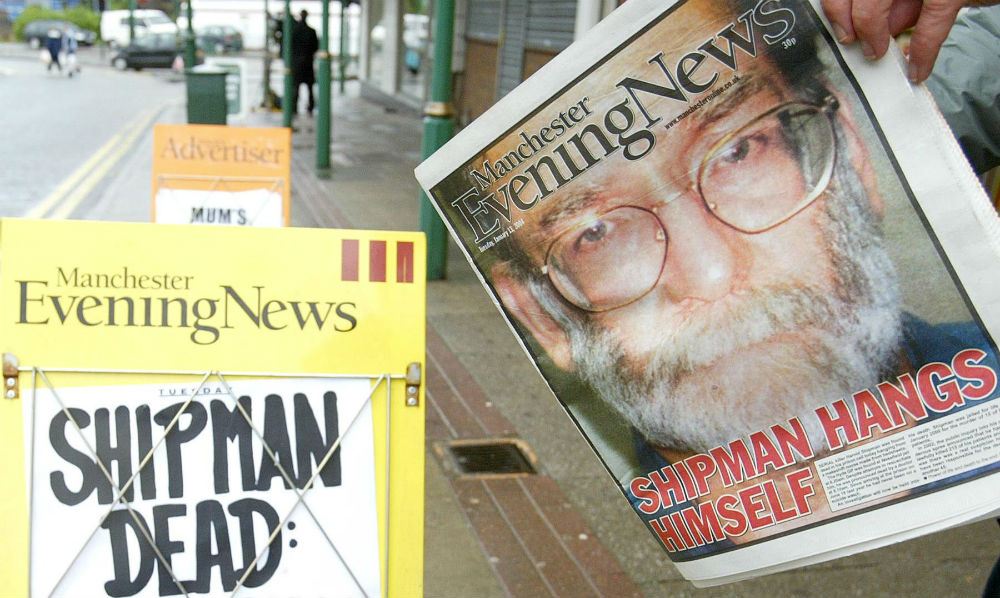NOTE: Our True Crime Tuesday series will highlight the stories of serial killers and other criminals, with potentially triggering and offensive detail discussed. Proceed with caution.
Last week, we delved into the horrendous murders and assaults carried out by The Ken and Barbie Killers, Paul Bernardo and Karla Homolka of Canada. Whilst one remains behind bars and is unlikely to ever be released, Homolka has been free for some time now, and even found work volunteering at a school. The case was a fascinating one, and certainly something that should have been given a more prominent focus across the globe, rather than just making leading headlines in Canada.
This week, we'll be looking at a case closer to home, which sent shivers down the spines of everybody in the United Kingdom, and had many wondering if there was anybody in the world they could ever completely trust...
Welcome back to True Crime Tuesday.

An introduction to this week's case
Harold Frederick Shipman is Britain's most prolific serial killer. Known to have killed at the very least 218 identified victims, with an inquiry finding that his victim count is in fact more likely to be 250+, he is the serial killer with the highest known victim count in the world.
For years, Shipman worked as a general practitioner in West Yorkshire and Hyde near Manchester, murdering patients and going undetected. His position as a doctor would allow him to sign death certificates and mark the cause of death in many of the cases as he saw fit. Nobody thought that this man charged with looking after so many could be capable of such evil things.
In reality, they were about to learn why this killer would eventually be called 'Doctor Death'.
Harold Shipman's medical career
Shipman's interest in medicine came at an early age, when he studied medicine at Leeds School of Medicine, and graduated in 1970. He began his official working life at Pontefract General Infirmary in West Riding of Yorkshire, before picking up his first position in 174, as a GP at the Abraham Ormerod Medical Centre in Todmorden, West Yorkshire.
His early career was not without controversy. In 1975, he would receive a fine of £600 after forging prescriptions of pethidine (Demerol) for his own use. Shipman also briefly took some time to attend a drug rehabilitation clinic in York, before moving his work to Hyde, near Manchester in 1977, becoming a GP at the Donneybrook Medical Centre.
There he would stay for a number of years, before beginning his own surgery at 21 Market Street in 1993. This allowed him to become a highly-respected member of the community, winning praise from many of those who had worked with him, or been a patient of his.
He'd even be interviewed for a Granada Television documentary in 1983, chatting about how the mentally ill should be treated by the wider community. The interview was re-broadcast in an edition of Tonight With Trevor McDonald, though it doesn't appear to be available on the web.

The criminal investigation against Harold Shipman
In March 1998, Shipman would find himself the subject of suspicion by fellow Donneybrook Surgery worker, Linda Reynolds. Speaking with the coroner for the South Manchester District, she expressed her concerns about Shipman's patients' high death rate. He would come to Reynolds to countersign cremation forms for elderly women, and the large amount brought through concerned her.
Police would be notified about the matter, but having been unable to find sufficient evidence to bring charges, the matter was dropped altogether. The Shipman Inquiry would later find that the force had assigned inexperienced officers to the case, leading to three more murders between the initial investigation being dropped, and Shipman's eventual arrest.
In August 1998, taxi driver John Shaw contacted the police and told them he was concerned about the deaths of 21 people who had been patients of Shipman. At the time, he worked as a taxi driver and had become close with a number of Shipman's victims, driving them to their appointments. Speaking with the BBC at the time, he explained: "They [the victims] became my friends. Then relatives would ring me and say 'Go and pick up my mum, she is dead'. I was asking who was their doctor? The thing that made me suspicious was that they had all been in good health prior to their deaths."
Shipman's greed would prove to be the nail in his coffin, as the daughter of his final victim, Kathleen Grundy, became concerned after her mother's will excluded her and her children, instead leaving £386,000 to Shipman. As a lawyer herself, Angela Woodruff (the daughter) reported the will to the police, who began an investigation.
Exhuming Grundy's body, an examination found traces of diamorphine (heroin), which is usually only used for pain control in terminal cancer patients. Shipman would claim that Grundy was an addict, showing comments made in his computerised medical journal that would back up what he said. A program on the computer which recorded actions however, would prove that those comments were entered after her death. Shipman was eventually arrested on September 7, 1998.
Police would then go on to look into other deaths certified by Shipman, creating a list of 15 to investigate and eventually discovering a pattern of lethal doses of diamorphine, administered to patients by Shipman. He would then sign death certificates, and falsify medical records after the fact, to push the idea forward that they had been in poor health for some time.
The trial
Shipman's trial would take place at Preston Crown Court. It started on October 5, 1999, with the disgraced doctor charged with the murders of Marie West, Irene Turner, Lizzie Adams, Jean Lilley, Ivy Lomas, Muriel Grimshaw, Marie Quinn, Kathleen Wagstaff, Bianka Pomfret, Norah Nuttall, Pamela Hillier, Maureen Ward, Winifred Mellor, Joan Melia and Kathleen Grundy. Each had been murdered with a lethal dose of diamorphine, between 1995 and 1998.
The trial would go on for a few months before the jury decided following six days of deliberations to find Shipman guilty on all 15 counts of murder, as well as one count of forgery in regards to the will.
Mr Justice Forbes accepted the guilty verdict, sentencing Shipman to life imprisonment on the recommendation he never be released, as well as a sentence of four years for forging Grundy's will.
Shipman maintained that he was innocent throughout the trial, with his wife also backing him up and claiming that he hadn't murdered anybody. She stuck by him even after the conviction.
Harold Shipman's suicide

Shipman would go out of the world on his own terms, hanging himself in his cell at Wakefield Prison on January 13, 2004. It was a day before he was to turn 58. He was pronounced dead at 8.10am. A statement from the prison explained that Shipman had hanged himself from the bars on the window of his cell, using bed sheets.
Never confessing or answering to his crimes, Shipman left the families of the victims without real closure. Whilst many were happy to see him go, others branded him a coward who would never be able to face up to the reality of his crimes.
Shipman's official motive for suicide wasn't ever recorded, but his probation officer claimed that he had said he considered suicide, so that his wife would be given financial security following his being stripped of his NHS pension. Following his death, Primrose did indeed receive a full NHS pension, which she wouldn't have been granted if her husband reached 60.
In conclusion
Though Shipman was sent to prison, his suicide means that his victims will never be granted full justice. A lack of a confession, or even acknowledging his guilt, allowed Shipman to go out of the world as a mystery, which goes against everything those who were affected by his crimes ever wanted.
Whilst he was a doctor, Shipman is the only British GP in medical history to be charged with murdering his patients. Hopefully, that's one legacy he'll keep...
Tagged in True Crime

